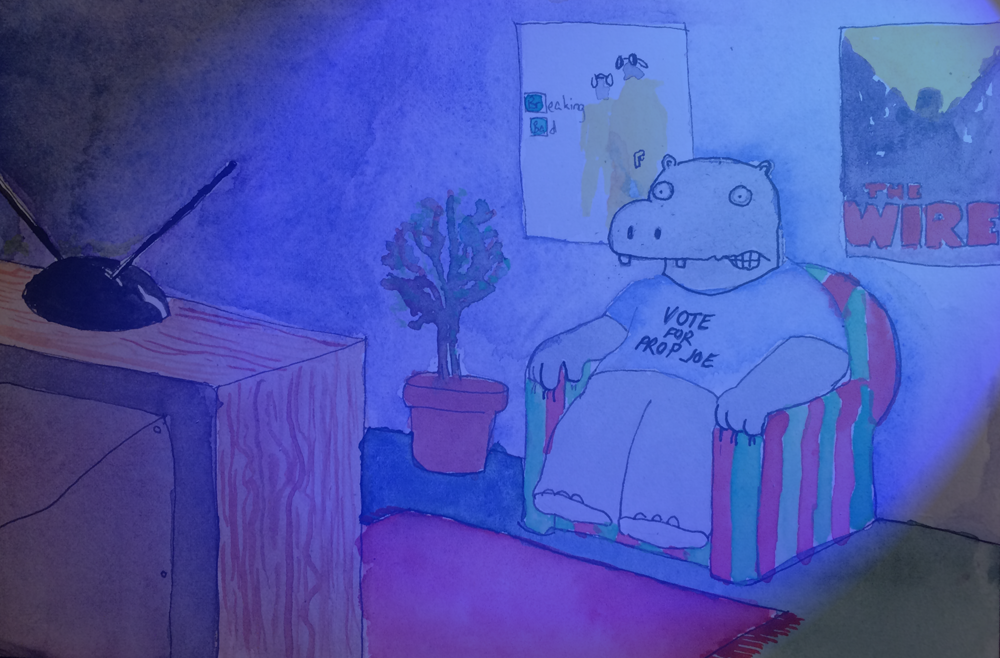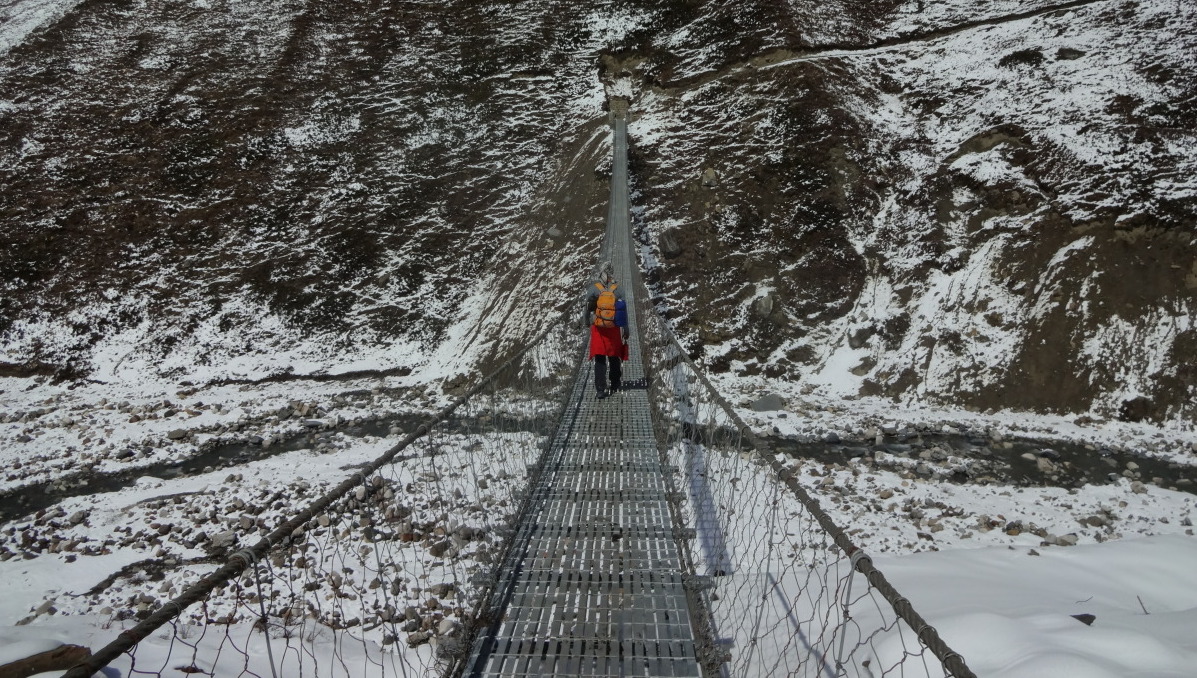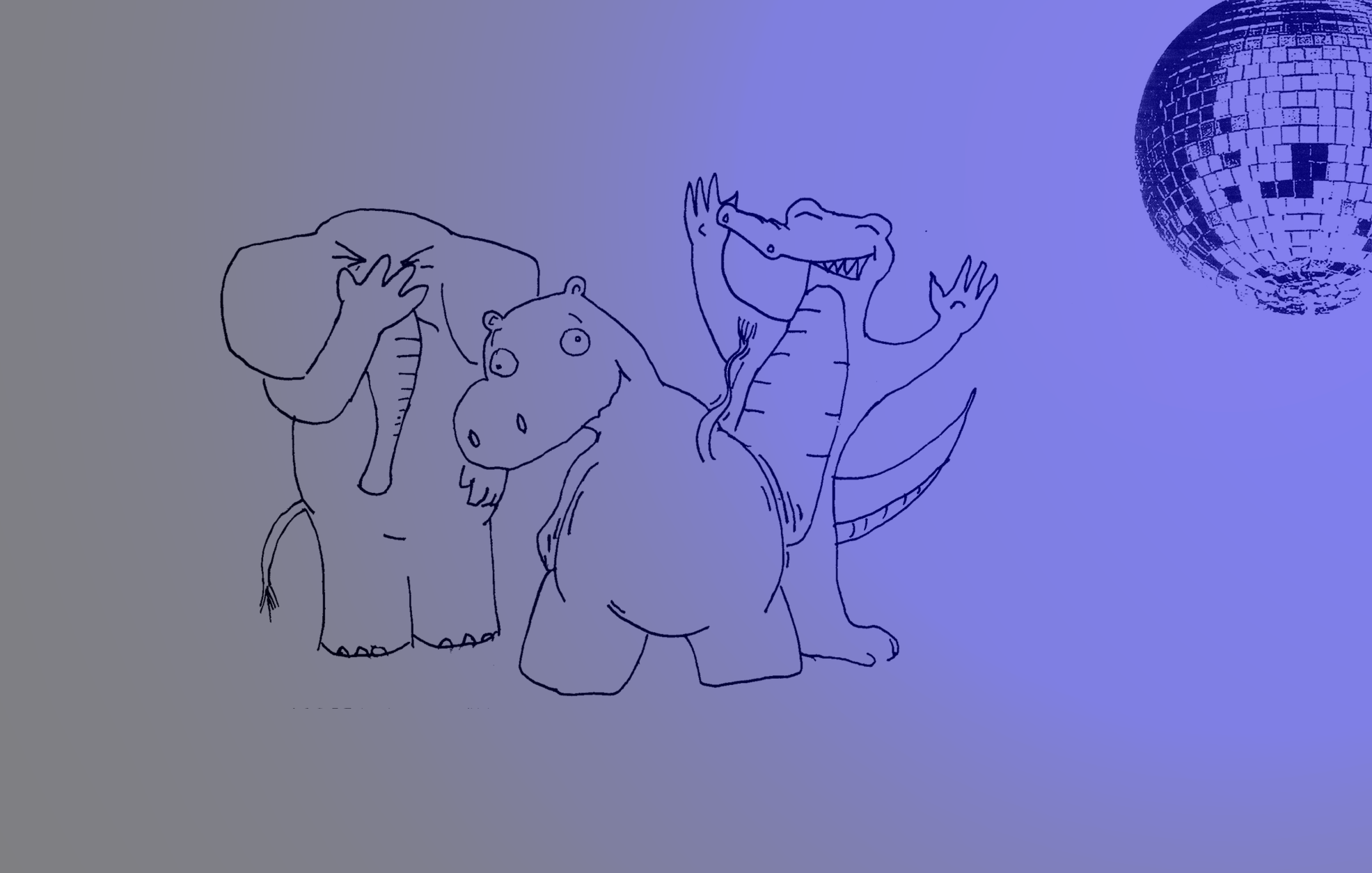ILLUSTRATION: Hippo Watching “The Mountain and the Viper” • watercolor on paper • 5×7″
We love living during Golden Ages. Try the ubiquitous Google autocomplete experiment, and type in “Golden Age of.” Then pass through the alphabet from “Athens” to “Zeppelins” to get a sense for just how many Golden Ages you’ve already lived through.[1] Thanks to the Golden Age of Hyperbole, we might even live in the Golden Age of Golden Ages.
Language being what it is, we also sometimes find ourselves in New Golden Ages —when we have been too quick to judge an earlier era’s merits—and Silver Ages—when we update the costumes of famous comic book characters—and Gilded Ages—a humorous and biting indictment of US society not incorrectly attributed to Mark Twain for once. Heck, we’ve had three New Gilded Ages in the last twenty years for those of us doomed to repeat history and bubbles and sit in traffic on the 101. But note: if you do find yourself in a Bronze Age or a Stone Age for a particular subject, it is incumbent on you to be nice and refer to it as “early innings.”
And so it’s been said that we live in a New Golden Age of Television (see here or here), but I think it’s remiss to do so as if this is merely a phenomenon of creativity, the logical necessity of talent and artistry progressing such that (legitimately wonderful) shows such as The Wire or Breaking Bad leap from the heads of their showrunning creators. Of course Steven Johnson is right when he talks about an evolution of TV complexity in Everything Bad is Good For You.[2] But befitting a Golden Age, you should do as Lester Freamon intones: Follow the money. “You don’t know where the **** it’s going to take you.” I think television content got better because a lot more money flowed into its creation, and that money got spent in more interesting ways.
Yes, over the course of the aughts, content quality fueled popularity which then fueled market growth and re-investment. But I’d argue that this era of television benefitted more from a short-term confluence of revenue growth from competing formats and competing windows, all while a fixed (or declining) amount of media time spent was fragmented across these myriad products. It’s the sustainability of these trends that we should worry about when we think of the art of scripted entertainment.
If you love TV, the sustainability of a particular kind of investment is worth discussing because even though artistic craft / progress is difficult for society or an institution to unlearn, the availability and distribution of investment can influence its flourishing. Overinvestment in one area can destroy a once vibrant art scene (Our Band Could Be Your Life-era underground -> Late-90s Grunge). A change in investment style can squander an artistic generation (00s theatrical investment in ‘franchises’ over spec scripts). And collapse can occasion the disappearance of knowledge or vibrancy. We lost the recipe for Roman concrete and Pantheon-like domes for ages after Rome’s fall, and the Renaissance sputtered to an end as the Medici Family and the Pope lost their spheres of influence. What, then, are our sources of TV patronage today?
From 2002 to 2013, US broadcast, local, and cable television advertising revenue grew from ~$58 billion to ~$74 billion. Some of that revenue flows back to content producers directly; some of it flows through local affiliate fees and syndication fees. During that same period, cable subscription revenue grew from ~$48 billion in 2002 to ~$105 billion. Revenue share flows back to broadcast and cable content producers through retransmission and carriage fees, respectively. The DVD market peaked in 2004 at $25 billion pre-Netflix, and TV box sets drove a large percentage of that. Speaking of the streaming giant, Netflix grew from zero to $5 billion in subscription revenue over this time (against an increasing amount of binge-friendly TV viewership) while YouTube grew similarly (but with only 10% going to traditional media after revenue share). You can throw in Hulu and other premium digital video advertising, Amazon Instant Video, iTunes, Google Play, Xbox Video and others’ pay-per-view and subscription revenues, too, some of which is subsidized by other, more profitable businesses.
That’s a cornucopia of overlapping revenue sources powering the creation of scripted entertainment and the acquisition / production of live sports: advertising, subscription, streaming, digital and physical retail, and other digital platforms. Investment in new platforms like streaming came while old platforms like syndication were still paying dividends. And with this new level of investment came different kinds of incentives.
For many channels, advertising no longer represented the majority of content revenue. Without having to satisfy advertisers, content creators could take on more risk with their stories. Streaming created additional library value for highly serialized stories (think 24) over episodic ones (think Law & Order) that typically ruled in syndication negotiations. The cable bundle became larger and more expensive fueling a fight for differentiation via content among a lot more players—HBO, Showtime, AMC, FX, USA, BET, Starz, ABC Family, etc.
As a result, we’ve had more pilots produced and picked up across a range of channels and products, more web series created, and an increase in budgets / cost per minute for the biggest sports and scripted spectacles from NFL games to Game of Thrones. Showrunners and talent have been given unprecedented control over the television product, mirroring the pattern of 1970s Hollywood film documented by Peter Biskind in Easy Riders, Raging Bulls. We’ve had greater diversity of product with higher production value all taking more risks than ever before in the pursuit of creative differentiation. If there were a creative equivalent of fracking, this would be it.
But what if all of that changed?
The human demand for narrative and fiction is limitless. However, over the next several years, each and every one of television’s revenue sources will transition, for good or for bad. These changes may or may not be kind to the talent or the fans of our New Golden Age of Television.
- Television advertising revenue may decline as time spent moves to digital platforms; at the same time, digital video advertising growth may not keep pace or may shift to non-traditional content types.
- US broadcast and non-MSO cable advertising is broadly shaped by brand advertising dollars spent upfront chasing elusive 18-24 year-olds and moms to establish long-term spending patterns. 18-24 year-olds watch less than half as much TV as demographics above 55, so TV advertising has grown by increasing its rate card ($27 to $47 for primetime 30s) against declining audiences in these key demos and investing heavily in the few live events that can maintain broad viewership patterns. Meanwhile, YouTube delivers video advertising priced to be attractive regardless of content quality, and Facebook and others deliver video advertising to audiences without even worrying about needing pesky ol’ video content. See the YouTube report I wrote with the Jefferies & Co. Internet team here for more on this…
- Local affiliate and syndication revenue will very likely decline, and streaming revenue may not grow fast enough to replace it.
- US local and MSO cable advertising is bought on spot price by hybrid brand / performance advertisers. Think car dealers, pharmaceuticals, old people scams, and during certain periods like now, politicians. This revenue comes back to content production in the form of local affiliate fees and syndication deals, but streaming, time shifting, and digital video all eat into the decidedly non-appointment viewing of Simpsons and Seinfeld reruns slapdashed into increasingly irrelevant 24-hour programming blocks. As supply shrinks, those advertisers may seek alternative, cheaper, more measurable buys…like YouTube.
- Cable subscription revenue to content producers (in the form of retrans and carriage fees) is at risk from plateauing subscriber growth, aforementioned youth TV trends, and alternative lower-priced streaming bundles.
- It doesn’t seem like MSOs are in any danger of losing revenue from cord cutting, but Hollywood sure is. To the extent that MSOs ever have to focus on data uber alles, it will certainly readjust the retrans and carriage fee arrangement. And so too, assuming flat subscriber growth, how much more price elasticity is there before demand plummets? What happens if cable is unbundled? How does consumer choice in a la carte pricing influence what sort of content gets funded compared to now?
- A la carte streaming services such as Netflix and Amazon are obviously growing subscribers, but consumers are spending much less, even on multiple services, than cable.
- One can subscribe to Netflix, Amazon Prime, and buy full seasons of 25 first-run shows via iTunes in HD for the cost of a $100/month cable subscription for a year. If it’s your predilection, you can replace those 25 first-run shows with 83 sporting events accompanied by beer and wings at Chili’s. So in this world, will cable revenue will be cannibalized? What happens to content quality if more people are paying closer to $7.99 per month than are paying $100+ per month for a cable bundle? Moreover, if Netflix or Amazon is the preeminent gatekeeper, what sort of content will be produced? The episode breaks of House of Cards remind me of an old Republic Pictures serial. I almost assumed like Chapter 3 of The Crimson Ghost that [spoiler alert] Kate Mara would be shown saving herself from the speeding train in the next episode after dying in the previous one.
- Finally, I think we all know that your used TV DVDs are on sale at Amoeba Records, and you’re waiting for the next season of your favorite show to come on Netflix instead of buying it on iTunes.
- The now haggard DVD market supported a lot of interesting diverse content, especially one-season wonders (like Wonderfalls), which compelled content producers to take higher risk chances on those creators in the future (leading, for example, to Pushing Daisies). What happens to artist revenue when we choose to subscribe versus support it directly? If video follows music, the money flowing to content production will decline.
Look, I’m generally bullish on the outlook for scripted content, as a popular form of entertainment and as an art form. I would love to make something someday. And it could be that the economics of the revenue sources in the list above are unevenly distributed now yet reflect an actual and consistent economic demand to be redistributed as trends wax and wane. But three things keep occurring to me…
First, we won’t be able to pay $7.99 per month for Netflix plus scrape by with Amazon Prime and YouTube and be able to expect the same quality of content we experienced during this New Golden Age.
Second, we should be careful what we wish for when we ask to unbundle things. The economics may be distributed more “fairly,” but also we may end up unhappily watching “Where Are My Pants?” or “Ow, My Balls.” (Or maybe writing on our blogs to no one. I’m very interested in bundling, unbundling, and rebundling as a broader economic trend in our society, and I plan to write more on this soon.)
Finally, nothing lasts forever—no episode, no season, no series, no Golden Age. To quote the Hagakure once again: “It is said that what is called ‘the spirit of an age’ is something to which one cannot return. That this spirit gradually dissipates is due to the world’s coming to an end. For this reason, although one would like to change today’s world back to the spirit of one hundred years or more ago, it cannot be done. Thus it is important to make the best out of every generation.”
On that note, The Wire ended more than six years ago. It’s probably time for me to let it go. We can all start talking about the Golden Age of Netflix or YouTube now. Oh wait.
[1] Speaking of Athens and Zeppelin, I’ve heard the Golden Age of Athens looked a lot like the album cover “Houses of the Holy.” [insert rimshot]
[2] I’ll tell the story of Steven Johnson explaining his thesis to a roomful of incredulous, fancy art patrons in the Berkshires another time.


